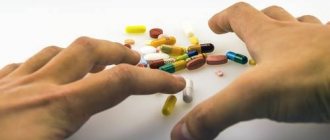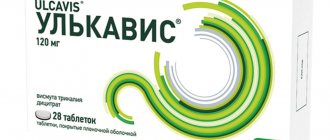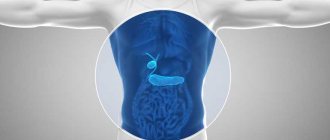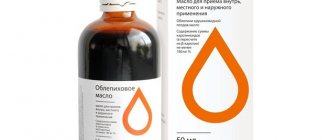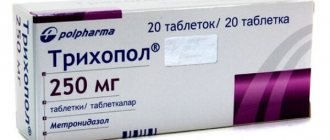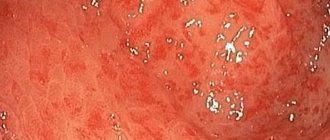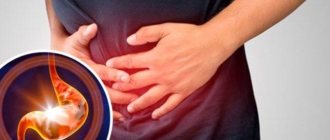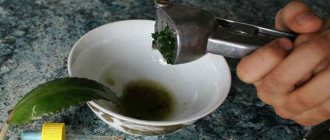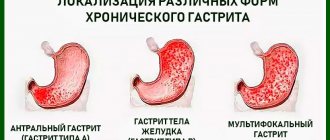The stomach is one of the main organs of the digestive system. It is located in the abdomen just below the ribs. Swallowed food is mixed with gastric juices containing enzymes and hydrochloric acid. The mucous membrane of the stomach, called epithelium, is multilayered. The epithelium is covered with mucus, which is produced by special glands. The balance between the production of aggressive digestive juices and the protection of the mucous membrane from aggression allows us to feel good. If the synthesis of acid and enzymes is impaired or there is not enough protective mucus, inflammation occurs. This is gastritis - damage to the gastric mucosa.
Gastritis is a term commonly used by patients and doctors to describe episodes of stomach discomfort (usually after eating), sometimes associated with nausea or vomiting. We also sometimes call this condition indigestion. However, strictly speaking, gastritis is the formal medical term for the diagnosis made by a pathologist when a biopsy taken during an endoscopy shows signs of inflammation and damage to the gastric mucosa. And it may seem strange, but when the term is truly used, there are usually no episodes of indigestion. There are two types of gastritis, acute and chronic.
What is acute gastritis?
Acute gastritis means a sudden inflammation of the gastric mucosa, which is caused by aggressive factors. When a gastroenterologist performs an endoscopy, the mucosa appears red and the samples show many acute inflammatory cells (mostly white blood cells). There may be small, fine tears on the surface of the mucosa, called acute erosions ("erosive gastritis"), and even tiny areas of bleeding.
What is chronic gastritis?
Chronic gastritis refers to long-term but mild inflammation and damage to the stomach lining. The lining of the stomach becomes thinner as normal cells are destroyed. Inflammatory cells include lymphocytes, which indicate an immune response. This is a very common disease. When gastritis has been present for many years, changes in the lining may progress to a stage called metaplasia, with a slight increase in the risk of stomach cancer.
Any form of gastritis requires adequate treatment, and you may need gastritis pills that eliminate inflammation, protect the mucous membrane from irritation, eliminate excess acid, or help suppress infection, as one of the key problems of inflammation.
Top 8 effective medications for the treatment of gastritis.
May 28, 2022
48802
4.7
10
Content
- Nolpaza
- Omez
- Nexium
- Gastal
- Rennie
- Maalox
- De-Nol
- Vikair
With gastritis, the gastric mucosa becomes inflamed, and a person experiences symptoms such as nausea, pain, belching, heartburn, etc. Today, gastritis is a very common occurrence, and the disease has become noticeably “younger” and is found even in children. If gastritis is not treated, it becomes chronic and significantly worsens the quality of life.
But you need to understand that there is no universal treatment for gastritis. It can be with high or low acidity, with or without the presence of Helicobacter pylori, with or without concomitant diseases, and many more individual characteristics. Therefore, only a doctor should prescribe drugs for gastritis.
We have compiled a rating of the safest and most effective medications for gastritis, working in three areas: antisecretory agents, antacids and drugs for the treatment of Helicobacter pylori.
The first group of drugs for the treatment of gastritis are drugs that reduce the acidity of gastric juice and the secretory activity of the stomach.
Contraindications
General contraindications for taking most tablets for gastritis are childhood, individual intolerance to individual components of the drugs, lactation or pregnancy. If you have serious problems with your liver or kidneys, you should consult your doctor. The specialist will select safe analogues of medications or adjust the dosage regimen.
Gastritis during pregnancy requires special treatment regimens. In some cases, doctors delay drug treatment until after the baby is born.
Nolpaza
These tablets for gastritis not only reduce the amount of hydrochloric acid in the stomach and reduce acidity, but are also indicated in complex therapy (in combination with antibiotics) for Helicobacter pylori. The active substance of Nolpaza, pantoprazole, heals the gastric mucosa during gastritis and ulcers, eliminating unpleasant symptoms. It is recommended to take Nolpaza once or twice a day; the drug is contraindicated for children. We recommend that you study the list of side effects.
Nolpaza
KRKA (KRKA), Slovenia
- gastroesophageal reflux disease (GERD), incl.
erosive and ulcerative reflux esophagitis and symptoms associated with GERD (heartburn, acid regurgitation, pain when swallowing); - erosive and ulcerative lesions of the stomach and duodenum associated with taking NSAIDs; — peptic ulcer of the stomach and duodenum, treatment and prevention; — eradication of Helicobacter pylori in combination with two antibiotics; - Zollinger-Ellison syndrome and other pathological conditions associated with increased gastric secretion. from 94
1337
- Like
- Write a review
Pathogenesis
The mechanism of pathogenesis is based on characteristic inflammation of the mucous membrane, which leads to its structural restructuring. If predisposing factors and the active influence of causes are present, the process of inflammation begins, which is characterized by a long course.
Chronitization is based on round cell inflammatory infiltration by neutrophils and other cells of the autoimmune system of the mucosa. Under the influence of the inflammatory reaction, the links in the restructuring of the shell structure and the development of active dysregenerative processes in it are triggered with a further transition to dystrophy and atrophy. The result of these processes is a quantitative change in hydrochloric acid.
The leading role is occupied by associated Helicobacter pylori, the second most common is drug-induced gastritis, and then atrophic.
Omez
This drug against gastritis perfectly reduces the production of stomach acid, thereby relieving discomfort. Omez became the first drug in its category, the effectiveness and safety of which were confirmed by research. The active substance of the drug is omeprazole. “Omez” forms a protective layer on the gastric mucosa and at the same time heals existing damage - the acute symptoms of gastritis disappear. "Omez" can be taken both for treatment and for preventive purposes (for example, when taking non-steroidal anti-inflammatory drugs) to protect the gastrointestinal tract.
Omez
Dr. Reddy's Laboratories, India
Adults - peptic ulcer of the stomach and duodenum (including prevention of relapses);
- gastroesophageal reflux disease (GERD); - hypersecretory conditions (Zollinger-Ellison syndrome, stress ulcers of the gastrointestinal tract, multiple endocrine adenomatosis, systemic mastocytosis); — eradication of Helicobacter pylori in infected patients with gastric and duodenal ulcers (as part of combination therapy); - prevention and treatment of damage to the mucous membrane of the stomach and duodenum caused by taking NSAIDs (NSAID gastropathy): dyspepsia, erosion of the mucous membrane, peptic ulcer; - prevention of Mendelssohn syndrome (aspiration pneumonitis). Children - treatment of gastroesophageal reflux disease in children over 2 years of age, weighing more than 20 kg; - treatment of duodenal ulcer caused by Helicobacter pylori in children over 4 years of age, weighing more than 20 kg. Safety and effectiveness of the drug for other indications in patients children over 60
1354
- Like
- Write a review
Popular questions and answers
We asked questions about the causes of gastritis and their elimination to gastroenterologist, therapist Vera Samsonova.
Why can there be gastritis?
Acute gastritis is caused by acute irritants that coat the mucous membrane that protects the stomach tissue.
Irritants include aspirin or other NSAIDs (nonsteroidal anti-inflammatory drugs), poisons (including strong alcohol), and some infections, including the early stages of Helicobacter pylori infection. The inflammation usually resolves quickly when the irritant is removed. Helicobacter pylori is one of many bacteria that is commonly found in the stomach. It is estimated that more than half the world's population has this bacteria but never experiences any problems. However, Helicobacter pylori infection may increase the risk of developing stomach cancer, gastritis, or peptic ulcers. Chronic gastritis usually results from Helicobacter Pylori infection. In our country, the infection is present in approximately 20% of children, and more than 50% of adults and elderly people. Infection rates among adults in underdeveloped countries can reach 90%.
Other causes of chronic gastritis may include:
● autoimmune disease; ● specific rare infections (ie HIV/AIDS); ● Crohn's disease; ● gastric operations, which increase the effect of bile entering it on the stomach.
What to do if you have gastritis?
Acute gastritis usually causes acute indigestion with upper abdominal pain or discomfort as the body tries to get rid of the irritant.
Other symptoms may include: ● nausea and vomiting, severe bloating with flatulence; ● weight loss or lack of appetite. In the vast majority of cases, chronic gastritis does not cause symptoms. When damage to the mucosa is severe and long-lasting, the stomach loses its ability to produce acid. This may cause digestive upset. There is also a loss of the ability to secrete a substance called intrinsic factor, which is necessary for the absorption of an important vitamin, B12. Vitamin B12 deficiency eventually leads to a condition called pernicious anemia.
When the symptoms of acute gastritis are quite severe, you need to see a doctor. Diagnosis can usually be made based on medical history. However, direct examination of the gastric mucosa using EGD is needed when the problem persists or bleeding occurs. Inflammatory changes are usually limited to the stomach. Other tests - blood tests, x-rays and scans - are not usually carried out unless an alternative condition is suspected during the test.
When should you call an ambulance?
Dangerous symptoms of gastritis that require immediate help should be: ● vomiting blood, black stools; ● constant nausea with vomiting and weight loss; ● severe malaise, dizziness, loss of consciousness.
Is it possible to do the treatment yourself?
Once the cause is determined, steps can be taken to avoid exposure.
For example, if alcohol causes inflammation, you may want to stop drinking alcohol or reduce the amount you drink. Anti-inflammatory drugs taken to treat other conditions may need to be stopped or replaced with others. Medications – Tablets are available to reduce stomach acid. You may need to take these medications for several weeks or months, depending on your situation.
Dietary modifications – such as limiting or avoiding alcohol and caffeine, which can irritate the stomach lining.
Nexium
This is a modern remedy for the treatment of gastritis and reflux disease, which has almost no side effects. Nexium is a proton pump inhibitor that permanently reduces the amount of acid in the stomach. Nexium helps relieve inflammation and heal stomach ulcers, and the effect after treatment lasts a long time. This drug for gastritis is not cheap, but the price is quite justified, especially since it can also be prescribed to children.
Nexium
AstraZeneca, Sweden
Gastroesophageal reflux disease: treatment of erosive reflux esophagitis;
long-term maintenance treatment after healing of erosive reflux esophagitis to prevent relapse; symptomatic treatment of gastroesophageal reflux disease; Peptic ulcer of the stomach and duodenum As part of combination therapy: treatment of duodenal ulcer associated with Helicobacter pylori; prevention of relapses of peptic ulcers associated with Helicobacter pylori. Long-term acid suppression therapy in patients who have suffered bleeding from a peptic ulcer (after intravenous use of drugs that reduce the secretion of gastric glands to prevent relapse). Patients taking NSAIDs for a long time: healing of gastric ulcers associated with taking NSAIDs; prevention of gastric and duodenal ulcers associated with taking NSAIDs in patients at risk. Zollinger-Ellison syndrome or other conditions characterized by pathological hypersecretion of the gastric glands, including from 127
1860
- Like
- Write a review
The next group of drugs are antacids, which eliminate excess acid in the stomach.
Gastal
"Gastal" are lozenges, so they are always convenient to have on hand and do not need to be washed down with water. It contains magnesium and aluminum, which instantly “quench” heartburn, and the positive effect lasts for about two hours after the tablet is dissolved. "Gastal" not only reduces acidity, but also helps the gastric mucosa to recover. The drug is prescribed in the complex treatment of gastritis and ulcers.
The course of treatment with Gastal is selected by the doctor; you can also use the drug as a one-time “first aid” to relieve the symptoms of heartburn. You can take no more than 8 Gastal tablets per day. It is important that side effects from taking this medication are very rare.
Gastal
TEVA, Ukraine
The combined drug Gastal contains aluminum hydroxide, magnesium carbonate and magnesium oxide.
The combination of active ingredients provides a high antacid (reducing stomach acidity) effect and reducing the possibility of constipation. from 100
1102
- Like
- Write a review
Read also: Top 5 best sorbents for poisoning Rating of the most effective and safe sorbents that help with poisoning and hangover syndrome.
Rennie
"Rennie" are heartburn tablets with different flavors (they are even available without sugar). Rennie contains calcium carbonate and magnesium hydroxycarbonate. In the stomach, this gastritis medicine neutralizes excess acid. At the same time, the drug increases the production of mucus, which protects the stomach and heals damage to the mucosa. "Rennie" begins to act very quickly - literally three to five minutes after administration. The big advantage of these tablets is that they can be taken by pregnant women (and heartburn is a common occurrence during this period).
Rennie
Bayer Bitterfeld GmbH, Germany
The drug is taken for diseases of the gastrointestinal tract associated with increased acidity of gastric juice
from 96
5.0 1 review
697
- Like
- Write a review
Which pills are better?
Tablets for gastritis differ in the name of the manufacturer and in price. Some patients prefer expensive products, others try to choose cheap analogues. Price and manufacturer don't matter. The main rule of treating a disease is a correctly designed treatment regimen. The drugs must complement each other and mutually enhance their pharmacological properties.
Nuances:
- taking any pills should be agreed with a gastroenterologist;
- if you take the pills incorrectly, you may develop drug-induced gastritis;
- the effectiveness of drug therapy will decrease if additional recommendations are not followed (balanced diet, avoiding stressful situations, giving up bad habits).
Maalox
"Maalox" for gastritis is presented in the form of chewable tablets and suspensions. This drug neutralizes hydrochloric acid and increases the pH level in the stomach. The active ingredients of Maalox are magnesium hydroxide and hydrated aluminum oxide. Also, this medicine for gastritis envelops the stomach, works as an adsorbent, and protects the mucous membrane from acid. "Maalox" is prescribed for gastritis, reflux esophagitis and ulcers. Before taking these tablets for gastritis, we recommend that you carefully read the contraindications.
Maalox
Chinoin (Sanofi-Sintelabo), Hungary
- peptic ulcer of the stomach and duodenum in the acute phase;
- acute gastroduodenitis; — chronic gastroduodenitis with normal or increased secretory function in the acute phase; - hiatal hernia; - reflux esophagitis; - dyspeptic phenomena, such as discomfort or pain in the epigastrium, heartburn, sour belching after errors in the diet, excessive consumption of ethanol, coffee, nicotine, etc.; - dyspeptic phenomena, such as discomfort or pain in the epigastrium, heartburn, sour belching (and their prevention), resulting from the use of certain medications (including NSAIDs, corticosteroids). from 20
923
- Like
- Write a review
The last group is bismuth preparations, which are prescribed for the treatment of Helicobacter pylori.
Classification, stages of the disease
In clinical practice in Russia, the working classification based on the developments of S. M. Ryss and the Sydney classification is most often used.
Working classification
According to etiology and pathogenesis:
- Type A
: characterized by autoimmune fundic atrophic processes, including those associated with Addison-Bearman anemia;
- Type B
: specific bacterial antral non-atrophic process associated with Hp;
- Type C
: a chemical form associated with reflux of lysolecithin, duodenogastric reflux, and also due to the use of medications;
- Type AB
: characteristic combined atrophic pangastritis, characterized by the involvement of all parts of the stomach in the process.
In addition, there are alcoholic, drug, radiation, lymphocytic, granulomatous eosinophilic and other forms of the disease.
According to topographer-morphological features
By localization:
- fundal;
- astral;
- pangastritis.
According to morphological criteria:
- surface form;
- interstitial;
- atrophic (mild, moderate or severe);
- with complete or partial intestinal metaplasia (small or large intestine).
According to specific morphological characteristics
According to the severity of inflammation:
- minimum;
- insignificant level;
- moderate;
- expressed.
By degree of activity:
- not active;
- mild;
- average;
- heavy.
According to the severity of coolant contamination:
- not expressed;
- lungs;
- average;
- tall.
According to the features of the clinic:
- with a predominance of pain (type B);
- with a predominance of dyspeptic disorders (type A);
- latent (asymptomatic).
According to functional criteria:
- with preserved secretion;
- with increased;
- with secretory insufficiency.
According to endoscopic criteria:
- erythematous (exudative);
- with flat (sharp) erosions;
- rising erosions (chronic);
- hemorrhagic;
- complicated by reflux gastritis;
- hyperplastic.
Separately, gastritis of unknown origin is distinguished, as well as of mixed origin.
The course of chronic hepatitis is characterized by two stages: relapse (exacerbation) and remission, gradually replacing each other.
specialist
Our doctors will answer any questions you may have
Tumasova Anna Valerievna Gastroenterologist
Stages of the disease
The disease occurs in 4 main stages:
- Hyperemic.
At the initial stage, the mucous membrane acquires a reddish color, and slight swelling appears.
- Hypertrophic.
At this stage, thickening of the mucosa occurs with a parallel decrease in hydrochloric acid. Changes are likely both in tissues and at the cellular level (dysplasia), as well as the accumulation of leukocytes (metaplasia).
- Atrophic.
As a result of a long-term ongoing process of inflammation, the mucous membrane becomes thinner, regenerative capacity decreases, and epithelial cells die off and are subsequently replaced by scar tissue.
- Erosive and/or ulcerative.
Due to thinning of the mucous membrane, focal lesions of varying depths form on the inner surface of the stomach.
With each subsequent exacerbation, these lesions deepen and grow, and the symptoms increase accordingly.
De-Nol
This medication contains 120 mg of bismuth per tablet. "De-Nol" destroys the bacterium Helicobacter pylori and protects the stomach from acid. De-Nol works best in combination with antibiotics. This drug must be prescribed by a doctor and is approved for children over 4 years of age. The cost of De-Nol is high, and while taking it you may experience constipation, and your stool may turn dark.
De-nol
Astellas Pharma Europe, Russia
De-Nol is an antiulcer drug containing the active substance – bismuth subcitrate.
De-Nol belongs to the group of astringent drugs, however, it has a multifaceted effect, influencing various parts of the pathogenesis of peptic ulcer disease. The main pharmacological effects of the drug include astringent, antimicrobial and gastrocytoprotective effects. from 302
1656
- Like
- Write a review
Vikair
This medicine for gastritis contains not only bismuth from Helicobacter pylori, but also plant components (buckthorn bark, calamus rhizome extract), as well as magnesium carbonate and sodium bicarbonate. This composition of Vikair makes it both an antispasmodic, an antacid and a drug with an astringent and laxative effect. The medicine has low cost and excellent effectiveness, so it is popular in the treatment of gastritis. But it is worth remembering that Vikair is contraindicated during pregnancy and children.
Vikair
Folk remedies for exacerbation
To eliminate the painful symptom of acute gastritis, you can resort to traditional medicine.
Method No. 1
Ingredients:
- ½ tbsp. milk;
- 1 teaspoon of natural honey.
Actions:
The prepared ingredients need to be mixed and heated. Consume in small portions. To prevent relapses, it is recommended to drink the drink every day in the morning.
Method No. 2
Components:
- ½ liter of boiling water;
- a couple of large l. crushed dried currant leaves.
Actions:
Place the raw materials in a thermos, then pour boiling water. Leave for 3 hours to infuse. The finished infusion should be filtered. The resulting medicine must be divided into 2 doses during the day within 30 minutes. before meals.
